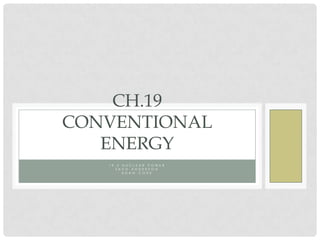
Apes ch. 19 pp 2.0
- 1. CH.19 CONVENTIONAL ENERGY 1 9 . 5 N U C L E A R P O W E R Z AC H AN D E R S O N AD AM C O R E
- 2. NUCLEAR POWER • Beginning in the early 1950’s, President Eisenhower wanted to move towards a more nuclear-powered society. He presented “Atoms for Peace” speech before the United Nations in 1953, pushing for nuclear-powered generators to provide clean, abundant energy. • He pushed for nuclear energy as an alternative resource because it would fill the deficit that came from shortages of oil and natural gas. • This was also a very cheap form of energy. • Between 1970-1974 American utilities ordered 140 new reactors for power plants. • However in recent decades, increasing construction costs, declining demand for electric power and safety issues have made nuclear energy far less favorable.
- 3. NUCLEAR REACTORS • The most commonly used fuel in nuclear power plants is U₂₃₅, which is a naturally occurring radioactive isotope of uranium. • Usually U₂₃₅ makes up less than 1% of uranium ore. • Many people who are exposed to uranium mines suffer from lung cancer due to high levels of radon and dust.
- 5. NUCLEAR REACTORS (CONTINUED) • U₂₃₅ concentrations must reach 3%, so it can be formed into cylindrical pellets. • 100 rods together make up a fuel assembly. These fuel assemblies are packed together in a heavy steel vessel. • The radioactive uranium particles produced are unstable and undergo nuclear fission, releasing energy and neutrons.
- 7. REACTOR DESIGNS • 70% of the nuclear plants in the world are pressurized water reactors, (PWR) where water circulates through the core and absorb heat as it cools the fuel rods. • There is a simpler, but dirtier and more dangerous reactor is the boiling water reactor (BWR). In this model, water from the reactor core boils to make steam, which directly drives the turbine-generators.
- 8. REACTOR USES • Britain, France, and the former Soviet Union all use a common reactor design that uses graphite, both as a moderator and as the structural material for the reactor core. Britain uses MAGNOX, while in the Soviet the RBMK was used. • These were all originally thought to be safe due to graphite’s high capacity for both capturing neutrons and dissipating heat. • One of the most well known disasters was at Chernobyl, caused from burning graphite.
- 9. ALTERNATIVE DESIGNS • HTGCR- High Temperature Gas-Cooled Reactor • PIUS- Process-Inherent Ultimate Safety reactor
- 10. HTGCR • Fuel pellets are encased in ceramic. • Helium is used as the coolant. • All Coolant can be lost and no meltdown will occur. • Examples: Brown’s Ferry Reactor in AL (failed) • General Atomic in Europe (successful) • Suffered complete coolant loss—survived.
- 11. PIUS
- 12. BREEDER REACTORS • Special reactors that create fuel from U238.
- 13. BREEDER REACTORS • Advantages • Disadvantages • Create enough fuel • Has to be run at to power nuclear high temperature so plants for 100+ years water can’t be • Use an abundant used as coolant. form of uranium Liquid Na is used. • Produce weapons grade plutonium.